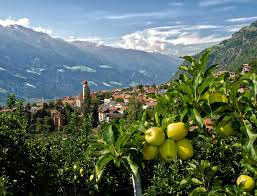Italy: Improved management, productive orchards

Rome: The high apple yields in Italy’s South Tyrol region are a result of improved management practices, the adoption of dense orchard plantings on dwarfing rootstocks, and the structure of the region’s extension services, says Laimburg Research Center’s Dr. Martin Thalheimer.
Until a decade ago, growers were planting super-high-density orchards of 3,000 to 4,800 trees per acre, with some orchards planted to double rows. Now, the trend is 1,200 to 1,600 per acre. “There were many failures in the past with the super-high-density plantings,” said the Laimburg agronomist. While the high-density orchards came into production quickly, tree cost was high and the double-row system had shading, fruit color, and quality shortcomings. Moreover, the double rows required more herbicides and pesticides than single rows. “In fact, the current integrated fruit production (IFP) program doesn’t allow the use of double rows.”
The Laimburg Research Center for Agriculture and Forestry is located near Bolzano. Founded in 1975 as a regional research institute, the center focuses on applied research and follows trials from the orchards and vineyards through packing and handling and postharvest storage. The center has 375 acres of apples and 90 acres of grapes, along with a small packing line, and 60 postharvest storage units.
Laimburg is funded without any state money—half of the budget comes from local government and the other half from the enterprise itself. Thalheimer explained that Laimburg is the biggest commercial grower in the area. The center has a staff of 80, not counting summertime help or harvest crews, and includes a vocational school for young horticulturists, a three-year program that gives young adults from 14-17 years old horticultural and computer/business skills needed for fruit production. About 150 students are enrolled at the school.
Thalheimer believes that the high productivity is not only a result of improved orchard systems, but also due to changes in management practices. Growers have adopted new strategies for irrigation, fertility, and crop protection.
Plant protection starts with protecting the buds and blossoms from freezing temperatures. In the 1950s and 60s, fans were used for frost protection, but today, overhead sprinklers are found to be more effective and are used in most orchards. A high water table in the region makes water cheap and abundant. Growers use high impact-type nozzles for frost protection, applying 0.2 inches of water per hour. However, Laimburg researchers are studying different nozzles and rates to see if less water can still be effective.
Growers begin putting up hail nets for protection around bloom time. Most growers use hail nets, though hail insurance is still available. Hail nets may have an added value of keeping out unwanted pests like codling moth, as the nets could serve as a physical barrier, but the netting also reduces sunlight and shading could be a downside. This is being studied in a trial at Laimburg.
Farmers are required to test their soil fertility every five years under IFP and must use the soil analysis to guide their nutrient program. Thalheimer believes this has helped reduce the overuse of nitrogen and other nutrients. Foliar fertilizers are used but fertigation is not common because injection systems are too expensive for small farmers who may have blocks in several locations.
Irrigation is used in all commercial orchards, either through overhead sprinklers or a drip system.
Deficit irrigation studies by Laimburg scientists have found that precisely managing irrigation to stress the trees later in summer can improve fruit quality without affecting size. Thalheimer notes that in the case of Golden Delicious, fruit subjected to deficit irrigation had a redder blush due to reduced tree vigor, less shading in the canopy, and less nitrogen and mineralization uptake by the tree.
“You can clearly see differences in irrigation levels in terms of fruit nitrogen,” he said. “Trees with less water had less nitrogen available in the dry soil and had less nitrogen in the fruit, which means better fruit coloring and storage qualities.”
Deficit irrigation trials have been conducted in the Vinschgau Valley near Merano, an area with less annual precipitation than Laimburg. Vinschgau receives around 21 inches of rainfall compared with Laimburg’s 32 inches. Trees need water after bloom for cell division, but it can be withheld later in summer. “The trick is to slow down shoot growth of the tree without affecting fruit size,” he said.





